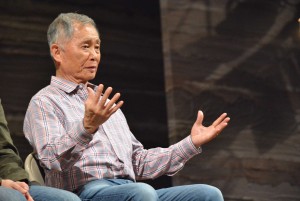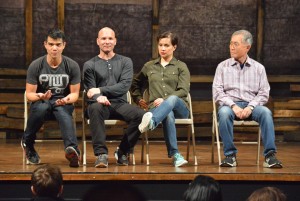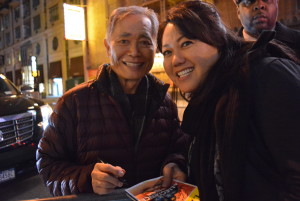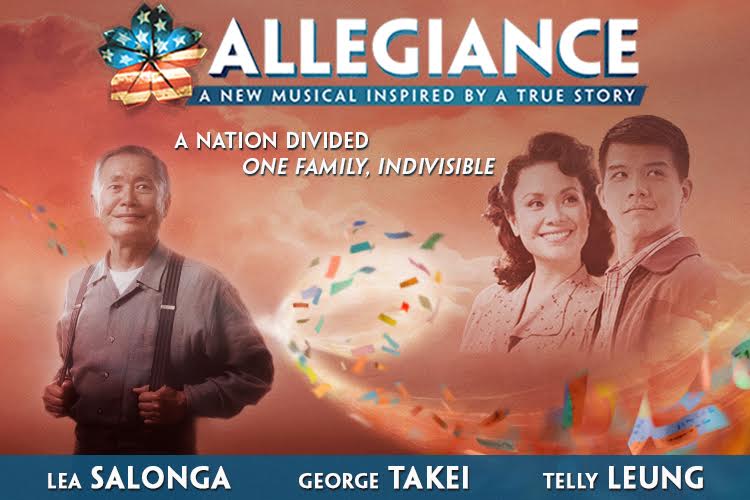After a November performance at the Longacre Theatre in New York’s fabled Broadway district, AARP members were invited for a “talkback” with George Takei and other cast members answering questions about their powerful musical, “Allegiance.” (NOTE: This post was riginally uploaded to the AARP AAPI Community Facebook page.)
“I remember we started the school day, each day, with the Pledge of Allegiance to the flag. I could see the barbed wire fence and the sentry tower right outside my school house window as I recited the words, ‘with liberty, and justice for all.’”
Takei recalled his experience as a child, sent with his entire family to a concentration camp along with more than 110,000 people of Japanese descent – including, like Takei, half who were born in the US and therefore American citizens – during World War II.
Now, at age 78, Takei is pledging again, making his Broadway debut in “Allegiance,” which tells the story of Japanese American incarceration inspired by Takei’s childhood. The parallels between the 1940s incarceration and the national mood today are striking. The news is filled with politicians speaking out against accepting refugees from the Middle East, and some are stoking a palpable fear within the public over Muslims.
Takei has spoken out eloquently on his vast social media networks in response to the hate-filled climate – he even invited David Bowers, the mayor of Roanoke, Virginia to come see a performance of “Allegiance” after the mayor announced he didn’t want any Syrian refugees in his city, and cited the Japanese American incarceration as a model. The mayor said the threat from ISIS via refugees is “just as real and serious as that from our enemies then.”
Takei criticized the mayor for his “galling lack of compassion” and added, “…one of the reasons I am telling our story on Broadway eight times a week in ‘Allegiance’ is because of people like you. You who hold a position of authority and power, but you demonstrably have failed to learn the most basic of American civics or history lessons. So Mayor Bowers, I am officially inviting you to come see our show, as my personal guest. Perhaps you, too, will come away with more compassion and understanding.”
Educating the public about what happened to Japanese Americans during World War II, when 120,000 people of Japanese heritage (half were US-born American citizens) were removed from the West Coast and sent to nine concentration camps as far east as Arkansas, is one of Takei’s lifelong goals. His family spent the war years in Rowher, Arkansas.
“I’m always shocked when I tell the story (of Japanese American incarceration) to people that I consider well-informed,” he said, “and they’re shocked and aghast that sometime like this could happen in the United States. It’s still little-known. So, it’s been my mission to raise the awareness of this chapter of American history.”
“Allegiance” accomplishes Takei’s goal with Broadway grandeur that matches any hit musical, with songs that soar and tug at heartstrings, tight choreography and a storyline that is familiar to many Japanese Americans, but not to the public at large.
 The script follows the life of Sam Kimura, with the opening scene featuring Takei as an aged Kimura learning that his sister has died. Then the narrative flashes back to pre-war California, where the Japanese American community thrived, until Japan attacked on Pearl Harbor. The play shifts to the emotional and cultural ties that bind families together – and sometimes tear them apart.
The script follows the life of Sam Kimura, with the opening scene featuring Takei as an aged Kimura learning that his sister has died. Then the narrative flashes back to pre-war California, where the Japanese American community thrived, until Japan attacked on Pearl Harbor. The play shifts to the emotional and cultural ties that bind families together – and sometimes tear them apart.
During the prewar scenes and when the Kimura family was imprisoned at Heart Mountain in Wyoming, Takei plays the role of the grandfather, who remains a wise blithe spirit in spite of the family’s hardships. The young Sam Kimura is played by Telly Leung. Lea Salonga, best-known for her Tony-winning lead role in “Miss Saigon,” plays the young Sam’s sister Kei.
The war and imprisonment split Japanese Americans in general, especially over a “Loyalty Questionnaire” that everyone in the camps was required to answer. Two questions set up the split, by asking if the person would foreswear loyalty to the Emperor of Japan (the vast majority weren’t loyal to Japan in the first place), and if the person would be willing to fight in the US military. Most Japanese Americans chose to answer “yes” and “yes” but some insisted that the imprisonment was wrong, and answered “no” and “no.” The “No-No Boys” were singled out as bad seeds and sent to a camp in Tule Lake, California.

The actors who participated in the talkback after a performance of “Allegiance”: From left, Telly Leung, Owen Johnston II, Lea Salonga and George Takei.
Sam Kimura chose to be one of these soldiers, even though his family was imprisoned stateside. The man Lea Salonga falls in love with became a No-No Boy – Frankie Suzuki (played by Michael K. Lee) fights the government’s treatment of Japanese Americans. The dynamics are stark and tense, but also believable; this happened to many Japanese American families.
The production is not only Takei’s Broadway debut; it’s a historic musical because it’s the first to ever make it to the Great White Way with a mostly Asian American cast, and Asian Americans behind the scenes as director, producers, writers and composer. It’s not a view of Asians through a white perspective (“Miss Saigon,” “Pacific Overtures”). It’s an Asian American story told by Asian Americans.
And the play came about through a chance meeting. It’s as if it was karma for Takei to bring this story to the stage.
In 2008, Takei and his husband, Brad were at a Broadway musical when they met a pair of fans in the row in front of them. The two were Jay Kuo, a writer and composer, and co-lead producer and writer Lorenzo Thione. Kuo recognized Takei’s deep voice and turned around and introduced himself.
The next night, the four happened to attend a different play, ’In the Heights” by Lin-Manuel Miranda, whose current hit “Hamilton” is the hottest ticket on Broadway. (Miranda has been a very vocal supporter of “Allegiance” and has even made a fun video with the “Allegiance” cast singing “Gaman” in front of “Hamilton.)
Looking across the theater, said Takei in an interview, “There were two arms waving at us, and it was Lorenzo and Jay again. Brad said I think they’re stalking us. The play was about a Puerto Rican family in New York struggling to make it. There was a powerful song near end of the first act, ‘Useless,’ that reminded me of a teenaged me talking to my father. I began to bawl. Jay and Lorezno asked me why and I shared my story. Jay said it has to be a musical.”
“I think it took a voice like George’s that carries with it that much credibility and authenticity,” recalled Kuo of that second chance meeting. “I knew when he was telling me, I got goosebumps.”
After interviewing Takei and thoroughly researching the WWII incarceration, Kuo, Thione and Marc Acito wrote the book and Kuo composed the music and wrote the lyrics for “Allegiance,” which debuted in San Diego in 2012. The current Broadway version has evolved since then, with fewer principal roles, different songs and changes in the script.
“We had to tell the story of not just one camp, but of 10 camps,” said Jay Kuo in an interview. “Not everything that happened in those camps happened at Heart Mountain. But, all the things we portrayed did happen in one of the camps. We had to squeeze a lot of education in the story!”
Kuo admitted that the month-long Broadway preview before the official November opening at the Longacre Theatre was stressful because of ongoing changes made and tested in front of live audiences.
“Sometimes they were learning stuff we gave them that morning, staging it, and then putting it on that night for 800-900 people. We changed all the lyrics to ‘What Makes a Man’ and there was one time Telly went up on all his lines and just made up the entire song completely. A friend said ‘Oh wow, that’s such an interesting choice – there’s so much silence during that song.’ He’s really Japanese that way,’” Kuo laughs now.
As for the songs, an original cast is in the studio this month to release a CD in January, and at the performances currently a “pre-Broadway mini-CD” of some of the songs, including the ensemble focal point “Gaman” and Salonga’s show-stopper “Higher,” is available during the intermission.
Tweaking the music was a constant task, Kuo said. “I rewrote the opening number, I rewrote the finale, I had several rewrites throughout the process. We cut half of one number, and the baseball number was completely revamped. I even wrote two songs to have ready to put in in case they yanked two of the songs. So I have songs that never even saw the light of day.”
One of the major changes since San Diego was the role of the real-life character Mike Masaoka, the national secretary and filed director for the Japanese American Citizens League, who urged Japanese Americans to go to the camps as a show of their patriotism, and later to join the US military again, to show their patriotism. Masaoka died in 1991.
In the original musical, the Masaoka character was criticized by JACL and some Japanese Americans. The role has since changed, though JACL still released an announcement when the Broadway version opened, stating its displeasure that the character and JACL were both in the play.

George Takei and other cast members signed autographs after a performance of “Allegiance” at the Longacre Theatre on Broadway.
“In this iteration I think he was not the villain,” agreed Watanabe in an interview. “I think he made some hard decisions that had heavy duty consequences.
“Mike Masaoka felt fear, and felt he needed to protect as many people as he could,” Watanabe added. He came from the idea of what choice do we have, so we’re going to comply.”
Floyd Mori, a friend of Masaoka and a longtime JACL leader, wrote a positive review and urged his readers to support the show because of the important larger story it tells, even if he didn’t agree with some of the details.
What’s important, said Kuo, is that the story of incarceration is getting a mainstream audience. He was an attorney before going fulltime into show business, and in law school he had studied the history of the camps from a legal perspective.
“So I’d always had a sort of a philosophical, intellectual interest in the question of the internment. What I didn’t know were the personal stories. George was the first person I’d ever met who was actually in a camp. And now, I’ve met hundreds.”
The cast and crew all took seriously the task of researching and understanding what happened in the past.
During the AARP talkback session, Lea Salonga noted, “Our creative team did their due diligence as far as research and passed on so much to every member of the company. Our company management also passed on so much documentation about Heart Mountain, about the internment – stuff that we as actors could then go home and read on our own time in order to put into our bodies and into our heads what this experience must have been like. Everyone on this production did their homework.
Leung said during the talkback that he didn’t know that much about those years before taking on the role. “I’m Chinese American, so learning about Japanese and Japanese American culture was something new to me.”
But he especially credited Takei for helping “train” him as a Japanese American. “The first resource I have is George who actually lived through the experience. So as an actor, it’s so useful to ask George all those sensory things: what did it look like, what did it smell like, what did it taste like? – all those things that are my actor tools when I’m up here that are sensory. Yes, you can read about internment in books as well, but for actors, that’s what’s useful.
“George has such vivid memories,” Leung said, “even down to I remember one day, he said, ‘my father wouldn’t have worn a hat like that.’ A lot of our cast members are also of Japanese descent so a lot of times they were also wonderful resources for me as well.”
Salong explained that her husband is half-Chinese American and half-Japanese American, and “he was raised more exposed to the Japanese side of his heritage. And he has uncles who have served on the 442nd – two of them. He himself says that it was an experience that my family never spoke about. They never talked about the internment. I think a lot of what ‘Allegiance’ is putting up on the stage is brand-new information even to him.”
Takei emphatically stated that’s why it’s so important to produce this play, and to ensure its success so many more people can see it and learn about the chapter of American history.
“Even for many younger Japanese Americans this is a brand-new story,” he said. “I discovered this after our San Diego run. These young Japanese Americans came backstage and told me that they knew that dad and mom, or grandpa and grandma, were in camps. That’s all they knew because they never talked about it. They were so pained, wounded, shamed by that experience that they didn’t share it with their children.
“For many younger Japanese Americans, seeing ‘Allegiance’ was the first time they learned about the Loyalty Questionnaire, to be challenged on our loyalty, a year into prison. Outrageous. We’re Americans! My mother was born in Sacramento. My father was in San Francisco. They met and married and had us in Los Angeles. We’re Americans. And for the government to presume that just because of our faces, we had an inborn, genetic loyalty to the Emperor, was insulting.”
The parallels to the level of racial tension and fear of foreigners that is boiling over now is obvious to Takei – and this performance and talkback happened days before the Paris attack, and weeks before the San Bernardino shootings.
“This story is so important, because it’s so relevant to our times today, where in our presidential nominating campaign, we have candidates who with a broad brush, paints all immigrants coming from south of the border, as criminals and rapists. We have the issue of Black Lives Matter, where young men, who happen to be African American, are seen as threatening to law enforcement officers and they could be shot at with impunity. It is a very relevant story, when a whole race of people are just assumed to be enemies.”
His hope, Takei said, is that “Allegiance” “starts off a lot of other conversations about this chapter of American history.”
And, makes audiences think about how its lessons can be applied today.
“Allegiance” is playing at the Longacre Theatre on Broadway in New York City, http://allegiancemusical.com.
The “Allegiance” website is a treasure-trove of information about the musical and the history of the Japanese American incarceration, as well as the history of the musical itself. You can see a fascinating nine-part documentary about the evolution of the musical and its journey from San Diego to Broadway. Start here with Episode #1.
Here’s a mix of YouTube videos from “Allegiance,” starting with Lea Salonga’s show-stopping solo ballad “Higher,” and including several videos of the “Allegiance cast hamming it up with Broadway hitmaker Lin-Manuel Miranda of “Hamilton”:











